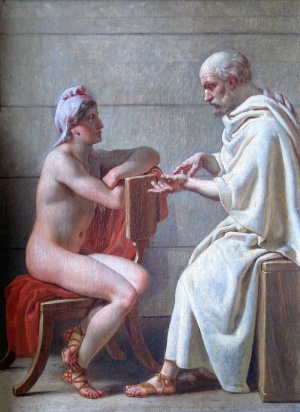Alcibiades: Difference between revisions
No edit summary |
No edit summary |
||
| Line 1: | Line 1: | ||
[[File:ECKERSBERG Christoffer Wilhelm 1815c Sokrates og Alkibiades 1611x2213.jpg|thumb| Socrates and Alcibiades / Christoffer Wilhelm Eckersberg. – 1813-1816. – Oil on canvas]] | |||
'''Alcibiades''', son of Cleinias, from the deme of Scambonidae (/ˌælsɨˈbaɪ.ədiːz/; Greek: Ἀλκιβιάδης Κλεινίου Σκαμβωνίδης, transliterated Alkibiádēs Kleiníou Skambōnidēs; c. 450 – 404 BC) historically was a Greek statesman and general. However, he has been best known posthumously as a disciple and especially the boy love ([[eromenos]]) of Socrates. This is clearly seen in Plutarch's life of Alcibiades <ref>[http://www.laits.utexas.edu/ancienthomosexuality/readindex.php?view=19 Homosexuality in Greece and Rome]</ref>, and in Plato's better-known ''Symposium''. He has been, in post-Renaissance times, a coded symbol of [[pederasty]]. <ref>[https://en.wikipedia.org/wiki/Alcibiades_(character) Alcibiades (character) (Wikipedia)]</ref> | '''Alcibiades''', son of Cleinias, from the deme of Scambonidae (/ˌælsɨˈbaɪ.ədiːz/; Greek: Ἀλκιβιάδης Κλεινίου Σκαμβωνίδης, transliterated Alkibiádēs Kleiníou Skambōnidēs; c. 450 – 404 BC) historically was a Greek statesman and general. However, he has been best known posthumously as a disciple and especially the boy love ([[eromenos]]) of Socrates. This is clearly seen in Plutarch's life of Alcibiades <ref>[http://www.laits.utexas.edu/ancienthomosexuality/readindex.php?view=19 Homosexuality in Greece and Rome]</ref>, and in Plato's better-known ''Symposium''. He has been, in post-Renaissance times, a coded symbol of [[pederasty]]. <ref>[https://en.wikipedia.org/wiki/Alcibiades_(character) Alcibiades (character) (Wikipedia)]</ref> | ||
''Alcibiades the Schoolboy'' (''L'Alcibiades, fanciullo a scola'') is a pro-sodomy dialogue in which Socrates (totally unhistorically) portrays the excellences of sexual love between master and (male) disciple. Wikipedia says: "It is a tour de force of pederastic fantasy and one of the frankest and most explicit texts on the subject to have been written before the twentieth century. It has been called "the first homosexual novel". <ref>[https://en.wikipedia.org/wiki/Alcibiades_the_Schoolboy Alcibiades the Schoolboy (Wikipedia)]</ref> | ''Alcibiades the Schoolboy'' (''L'Alcibiades, fanciullo a scola'') is a pro-sodomy dialogue in which Socrates (totally unhistorically) portrays the excellences of sexual love between master and (male) disciple. Wikipedia says: "It is a tour de force of pederastic fantasy and one of the frankest and most explicit texts on the subject to have been written before the twentieth century. It has been called "the first homosexual novel". <ref>[https://en.wikipedia.org/wiki/Alcibiades_the_Schoolboy Alcibiades the Schoolboy (Wikipedia)]</ref> | ||
{{clr}} | |||
==References== | ==References== | ||
{{reflist}} | {{reflist}} | ||
{{Mediaboywiki|title=''Alcibiades''|Category:Alkibiadēs}} | |||
[[Category:Ancient Greece]] | [[Category:Ancient Greece]] | ||
Revision as of 11:54, 21 December 2014

Alcibiades, son of Cleinias, from the deme of Scambonidae (/ˌælsɨˈbaɪ.ədiːz/; Greek: Ἀλκιβιάδης Κλεινίου Σκαμβωνίδης, transliterated Alkibiádēs Kleiníou Skambōnidēs; c. 450 – 404 BC) historically was a Greek statesman and general. However, he has been best known posthumously as a disciple and especially the boy love (eromenos) of Socrates. This is clearly seen in Plutarch's life of Alcibiades [1], and in Plato's better-known Symposium. He has been, in post-Renaissance times, a coded symbol of pederasty. [2]
Alcibiades the Schoolboy (L'Alcibiades, fanciullo a scola) is a pro-sodomy dialogue in which Socrates (totally unhistorically) portrays the excellences of sexual love between master and (male) disciple. Wikipedia says: "It is a tour de force of pederastic fantasy and one of the frankest and most explicit texts on the subject to have been written before the twentieth century. It has been called "the first homosexual novel". [3]
References
Media-BoyWiki
has media related to
Alcibiades